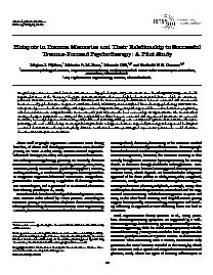Hotspots in Trauma Memories and Their Relationship to Successful Trauma-Focused Psychotherapy: A Pilot Study
Imaginal exposure is an essential element of trauma-focused psychotherapies for posttraumatic stress disorder (PTSD). Exposure should in particular focus on the “hotspots,” the parts of trauma memories that cause high levels of emotional distress which are often reexperienced. Our aim was to investigate whether differences in the focus on hotspots differentiate between successful and unsuccessful trauma-focused psychotherapies. As part of a randomized trial, 45 PTSD patients completed brief eclectic psychotherapy for PTSD. We retrospectively assessed audio recordings of therapy sessions of 20 patients. Frequency of hotspots and the associated emotions, cognitions, and characteristics were compared for the most successful (n = 10) versus the least successful (n = 10) treatments. The mean number of unique hotspots per patient was 3.20, and this number did not differ between successful and unsuccessful treatments. In successful treatments, however, hotspots were more frequently addressed (r = .48), and they were accompanied by more characteristics of hotspots (r = .39), such as an audible change in affect, indicating medium- to large-sized effects. Repeatedly focusing on hotspots and looking for associated characteristics of hotspots may help clinicians to enhance the efficacy of imaginal exposure for patients who would otherwise show insufficient response to treatment.
Geachte bezoeker,
De informatie die u nu opvraagt, kan door psychotraumanet niet aan u worden getoond. Dit kan verschillende redenen hebben,
waarvan (bescherming van het) auteursrecht de meeste voorkomende is. Wanneer het mogelijk is om u door te verwijzen naar de bron
van deze informatie, dan ziet u hier onder een link naar die plek.
Als er geen link staat, kunt u contact opnemen met de bibliotheek,
die u verder op weg kan helpen.
Met vriendelijke groet,
Het psychotraumanet-team.
Reference:
B. Gersons, M.J. Nijdam, M.A. Baas, M. Olff | 2013
In: Journal of Traumatic Stress, ISSN 0894 ¬9867 | 26 | 1 | februari | 38-44
http://onlinelibrary.wiley.com/doi/10.1002/jts.21771/abstract;jsessionid=8C40AADA72ADFC172158CB7353D47281.f03t03
In: Journal of Traumatic Stress, ISSN 0894 ¬9867 | 26 | 1 | februari | 38-44
http://onlinelibrary.wiley.com/doi/10.1002/jts.21771/abstract;jsessionid=8C40AADA72ADFC172158CB7353D47281.f03t03


